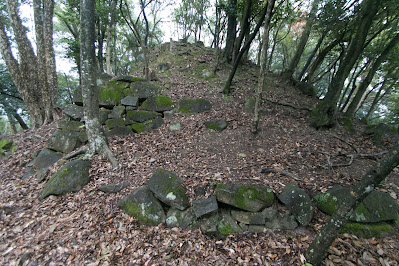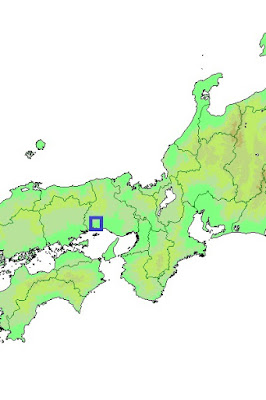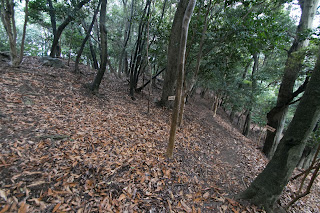Tatsuno Castle
-Combination of medieval mountain castle and modern residence-
Overview
Name: Tatsuno castle (Tatsuno-jo)
Alias:
Place: Tatsuno-cho Tatsuno city, Hyogo
Location: 34.86940744332761, 134.54861391146406
Type: Mountain castle, Hill castle
Built: 15th century
Remaining remnants: Stone walls, clay walls and dry moats
Title:
Tatsuno castle (龍野城) is located at hilltop and hillside of Keirouzan countain, a 200 meter height ridge of Matobayama mountain at the center of Tatsuno city. Tatsuno city is located at the western edge of Harima plain, and entrance into central mountain area and Sanin region by Inaba Kaido road (current Route 29) along Ibo-gawa river.
Throughout Muromachi era, western part of Harima country (south half of Hyogo prefecture) was governed by Akamatsu clan. Akamatsu clan was originally local retainer of this area, but at the beginning of 14th century, Norimura Akamatsu (1277-1350, known as his Buddhist name Enshin) cooperated anti Kamakura Shogunate movement of Emperor Godaigo (1288-1339) and appeared into the center stage of history.
Norimura was treated coldly under the new government of Emperor Godaigo, and supported Takauji Ashikaga (1305-1358) and contributed to his establishment of Muromachi Shogunate. Due to this achievement Akamatsu clan became one of the largest lord governed Settsu province (Osaka prefecture), Harima country, Bizen country and Mimasaka province (Okayama prefecture) under Muromachi shogunate.
But in 1441 Mitsusuke Akamatsu (1381-1441), the leader of the clan at that time, assassinated Yoshinori Ashikaga (1391-1441), the sixth Shogun of Muromachi Shogunate and seemed as tyrant, then Akamatsu clan was subjugated and lost territories except for Harima country (Incident of Kakitsu). But at the latter half of 15th century Akamatsu clan recovered Bizen province and Mimasaka province due to the achievement in the battle of Onin.
In 15th century, Akamatsu clan rapidly lost their power. Mimasaka province was deprived by Amago clan, a warlord of Izumo province (Shimane prefecture), and Uragami clan and Bessho clan, a major retainer of Akamatsu clan, grew their power at Bizen province and east half of Harima province respectively. Among such situation, Akamatsu clan still kept their authority at the western half of Harima country through Tatsuno Akamtsu clan, their branch family.
Tatsuno Akamatsu clan was a branch family of Akamatsu clan stem from 15th century and built Tatsuno castle at the beginning of 16th century. Masahide Akamatsu (?-1570), the leader of Tatsuno Akamatsu clan, grew their power all over the western half of Harima province, and fiercely fought with Uragami clan, a warlord of Bizen province and Kuroda clan, a retainer of Kodera clan and the house of Yoshitaka Kuroda (1546-1604, known as Kanbe).
Type: Mountain castle, Hill castle
Built: 15th century
Remaining remnants: Stone walls, clay walls and dry moats
Title:
Brief History
Tatsuno castle (龍野城) is located at hilltop and hillside of Keirouzan countain, a 200 meter height ridge of Matobayama mountain at the center of Tatsuno city. Tatsuno city is located at the western edge of Harima plain, and entrance into central mountain area and Sanin region by Inaba Kaido road (current Route 29) along Ibo-gawa river.
Rise and fall of Akamatsu clan
Throughout Muromachi era, western part of Harima country (south half of Hyogo prefecture) was governed by Akamatsu clan. Akamatsu clan was originally local retainer of this area, but at the beginning of 14th century, Norimura Akamatsu (1277-1350, known as his Buddhist name Enshin) cooperated anti Kamakura Shogunate movement of Emperor Godaigo (1288-1339) and appeared into the center stage of history.
Norimura was treated coldly under the new government of Emperor Godaigo, and supported Takauji Ashikaga (1305-1358) and contributed to his establishment of Muromachi Shogunate. Due to this achievement Akamatsu clan became one of the largest lord governed Settsu province (Osaka prefecture), Harima country, Bizen country and Mimasaka province (Okayama prefecture) under Muromachi shogunate.
But in 1441 Mitsusuke Akamatsu (1381-1441), the leader of the clan at that time, assassinated Yoshinori Ashikaga (1391-1441), the sixth Shogun of Muromachi Shogunate and seemed as tyrant, then Akamatsu clan was subjugated and lost territories except for Harima country (Incident of Kakitsu). But at the latter half of 15th century Akamatsu clan recovered Bizen province and Mimasaka province due to the achievement in the battle of Onin.
In 15th century, Akamatsu clan rapidly lost their power. Mimasaka province was deprived by Amago clan, a warlord of Izumo province (Shimane prefecture), and Uragami clan and Bessho clan, a major retainer of Akamatsu clan, grew their power at Bizen province and east half of Harima province respectively. Among such situation, Akamatsu clan still kept their authority at the western half of Harima country through Tatsuno Akamtsu clan, their branch family.
Build and expansion of mountain castle area
Tatsuno Akamatsu clan was a branch family of Akamatsu clan stem from 15th century and built Tatsuno castle at the beginning of 16th century. Masahide Akamatsu (?-1570), the leader of Tatsuno Akamatsu clan, grew their power all over the western half of Harima province, and fiercely fought with Uragami clan, a warlord of Bizen province and Kuroda clan, a retainer of Kodera clan and the house of Yoshitaka Kuroda (1546-1604, known as Kanbe).
Masahide stroke back the attack of Uragami clan and Kuroda clan and once became an independent warlord, but when he attacked Kuroda clan in 1569, he suffered severe defeat against Yoshitaka and retreated. Due to this defeat Masahide lost his power, and had to surrender to Uragami clan.
After the death of Masahide his son Hirohide Akamatsu (1562-1600) succeeded the clan, but was attacked by Oda army lead by Hideyoshi Hashiba (1537-1598, later Hideyoshi Toyotomi) and surrendered. Later Hirohide became the commander of Takeda castle (Hyogo castle) under Hideyoshi, but was forced to suicide by the failure at the battle of Sekigahara in 1600 and the house of Akamatsu clan was extinguished.
Hideyoshi who captured Tatsuno castle appointed Masakatsu Hachisuka (1526-1586), one of the oldest retainer of Hideyoshi, as a commander of Tatsuno castle. In 1585, after the Shikoku campaign, Hachisuka clan moved to Tokushima castle (Tokushima prefecture).
After the death of Masahide his son Hirohide Akamatsu (1562-1600) succeeded the clan, but was attacked by Oda army lead by Hideyoshi Hashiba (1537-1598, later Hideyoshi Toyotomi) and surrendered. Later Hirohide became the commander of Takeda castle (Hyogo castle) under Hideyoshi, but was forced to suicide by the failure at the battle of Sekigahara in 1600 and the house of Akamatsu clan was extinguished.
Hideyoshi who captured Tatsuno castle appointed Masakatsu Hachisuka (1526-1586), one of the oldest retainer of Hideyoshi, as a commander of Tatsuno castle. In 1585, after the Shikoku campaign, Hachisuka clan moved to Tokushima castle (Tokushima prefecture).
As a castle to guard Himeji castle (Hyogo prefecture), an important base of Toyotomi government, Hideyoshi placed his relative such as Masanori Fukushima (1561-1624) , Katsutoshi Kinoshita (1569-1649) or Yoshimasa Koide (1565-1613) as commanders of this castle. During their period, the mountain castle part of Tatsuno castle was improved into a modern castle equipped stone walls. The hilltop area consist of over 20 terraces spreads along the ridge over 500 meter, and major areas equipped stone walls and had combined gates.
After the battle of Sekigahara, Ikeda clan governed whole Harima country including Tatsuno castle, and Tatsuno castle was maintained as a branch castle. Subsequent to Ikeda clan, Honda clan, Ogasawara clan and Kyogoku clan became the commander, but at the time of transfer of Kyogoku clan to Marugame castle in 1658, Tatsuno castle was once abolished.
In 1672, Wakizaka clan was transferred from Iida castle (Nagano prefecture) and became the governor of Tatsuno domain. Yasuharu Wakizaka (1554-1626) was a general grew under Hideyoshi Toyotomi and known as one of the seven braves at the battle of Sekigahara and served the commander of Sumoto castle (Hyogo prefecture), and later Wakizaka clan became the retainer of Tokugawa clan and served the commander of Ozu castle (Ehime prefecture) and Iida castle.
As Tatsuno castle was totally destructed Wakizaka clan had to rebuilt the castle, but considering Edo Shoguate they only rebuilt the residence at hillside area. Wakizaka clan had managed Tatsuno castle and Tatsuno castle until the end of Edo era, and contributed to the development of the city, thus they were still respected in Tatsuno city.
Subsequent to Meiji revolution all buildings except for several gates were lost, but turret and gate at hillside area were rebuilt and the castle recovered the sophisticated atmosphere of Edo era. Hilltop areas are 20 minutes walk from hillside area through steep slope, and continuing broken stone walls spread over the area still kept the image of magnificent medieval castle.
20 minutes walk from JR West Kishinsen line Hontatsuno station. 10 minutes drive from Sanyo Expressway Tatsuno interchange. 40 minutes walk from hillside castle to hilltop castle.
Takeda Castle- Castle guarded vital area of Toyotomi government-
Sumoto Castle -Magnificent castle guarded Awaji island-
Ozu Castle -Final winner among the seven braves at Shizugatake-
Tokushima Castle -Survived descendant of Hideyoshi's oldest confident-
Abolish and rebuilt of castle
After the battle of Sekigahara, Ikeda clan governed whole Harima country including Tatsuno castle, and Tatsuno castle was maintained as a branch castle. Subsequent to Ikeda clan, Honda clan, Ogasawara clan and Kyogoku clan became the commander, but at the time of transfer of Kyogoku clan to Marugame castle in 1658, Tatsuno castle was once abolished.
In 1672, Wakizaka clan was transferred from Iida castle (Nagano prefecture) and became the governor of Tatsuno domain. Yasuharu Wakizaka (1554-1626) was a general grew under Hideyoshi Toyotomi and known as one of the seven braves at the battle of Sekigahara and served the commander of Sumoto castle (Hyogo prefecture), and later Wakizaka clan became the retainer of Tokugawa clan and served the commander of Ozu castle (Ehime prefecture) and Iida castle.
As Tatsuno castle was totally destructed Wakizaka clan had to rebuilt the castle, but considering Edo Shoguate they only rebuilt the residence at hillside area. Wakizaka clan had managed Tatsuno castle and Tatsuno castle until the end of Edo era, and contributed to the development of the city, thus they were still respected in Tatsuno city.
Subsequent to Meiji revolution all buildings except for several gates were lost, but turret and gate at hillside area were rebuilt and the castle recovered the sophisticated atmosphere of Edo era. Hilltop areas are 20 minutes walk from hillside area through steep slope, and continuing broken stone walls spread over the area still kept the image of magnificent medieval castle.
Access
20 minutes walk from JR West Kishinsen line Hontatsuno station. 10 minutes drive from Sanyo Expressway Tatsuno interchange. 40 minutes walk from hillside castle to hilltop castle.
Related Castles
Takeda Castle- Castle guarded vital area of Toyotomi government-
Sumoto Castle -Magnificent castle guarded Awaji island-
Ozu Castle -Final winner among the seven braves at Shizugatake-
Tokushima Castle -Survived descendant of Hideyoshi's oldest confident-


































































































































































































































































































































No comments:
Post a Comment